Giant Breeds (Over 90 lbs): Care & Tips Guide
Did you know that giant dog breeds can weigh over 90 lbs? These oversized canines require specialized care to ensure their health and well-being. Whether you already have a giant breed dog or are considering adding one to your family, this comprehensive care guide will provide you with essential tips and information to keep your large furry friend happy and healthy.
Key Takeaways:
- Proper care for giant breeds is essential due to their size and unique needs.
- Physical activity, nutrition, spay/neuter decisions, training, and living arrangements all require special consideration for giant breeds.
- Budgeting for the additional expenses of owning a large dog is important for their overall well-being.
- Recognizing the changes that come with age in senior dogs helps ensure their quality of life.
- Consulting with veterinarians and seeking their guidance is crucial for the health and happiness of your giant breed.
Physical Activity for Large-Breed Puppies
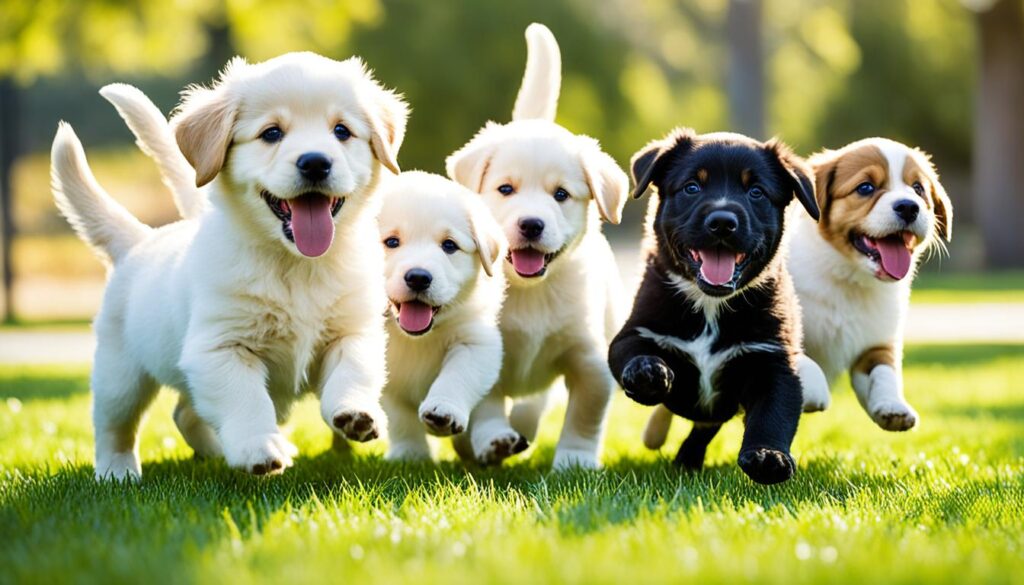
Large-breed puppies, especially those from working lines, require plenty of exercise to support their growth and development. However, it is crucial to consider their unique physiology and take precautions to prevent potential joint harm and trauma. The slower fusion of growth plates in large breeds necessitates careful management of their physical activities.
When it comes to exercise for these puppies, it is recommended to prioritize self-regulated play with other well-mannered dogs on softer surfaces such as grass or sand. This choice of surface helps reduce the impact on their joints during energetic play sessions. Additionally, it is essential to avoid exercises that involve excessive jumping or repetitive movements until the growth plates have fully fused, typically around 16 to 18 months of age.
Training modifications are often necessary for certain sports, such as agility, to prevent potential injuries and allow for the safe development of the puppy’s musculoskeletal system. It is best to consult with a professional trainer who has experience working with large breed puppies to ensure appropriate modifications based on their stage of growth. By taking these precautions, we can ensure that our large-breed puppies enjoy the benefits of physical activity without compromising their long-term joint health.
Examples of Suitable Activities for Large-Breed Puppies:
- Interactive play sessions with toys that encourage movement and mental stimulation
- Controlled walks on soft surfaces to minimize joint impact
- Swimming, which provides a low-impact and full-body workout
- Puppy obedience classes that focus on impulse control and basic commands
Training Tips for Large-Breed Puppies:
- Start with basic obedience training, focusing on commands like sit, stay, and come
- Use positive reinforcement techniques, such as treats and praise, to motivate and reward desired behaviors
- Gradually introduce more advanced training exercises once the puppy’s growth plates are fully fused
- Ensure regular socialization with other dogs and animals to encourage proper behavior and reduce anxiety
Remember to consult with your veterinarian and a professional trainer to develop an exercise and training plan tailored to your individual large-breed puppy’s needs.
| Activity | Description | Benefits |
|---|---|---|
| Interactive Play | Encourage play sessions with appropriate toys to engage the puppy mentally and physically | Enhances cognitive development and strengthens the bond between puppy and owner |
| Controlled Walks | Take your puppy for walks on softer surfaces, such as grass or sand, to reduce joint impact | Provides low-impact exercise and helps improve cardiovascular health |
| Swimming | Allow your puppy to swim in a safe and supervised environment | Offers a low-impact and full-body workout, strengthening muscles without stressing joints |
| Obedience Training | Enroll your puppy in obedience classes to learn basic commands and improve behavior | Establishes a foundation for good behavior and strengthens the bond between puppy and owner |
Nutrition for Large-Breed Puppies

Large-breed puppies have unique nutritional requirements that differ from smaller breeds. A well-balanced diet is crucial to support their growth and development. Here are some key factors to consider when it comes to nutrition for large-breed puppies:
Energy Density in Growth Diets
Energy density refers to the amount of calories per serving in a puppy’s diet. Since large-breed puppies have slower growth rates compared to smaller breeds, it’s important to avoid overfeeding and excessive weight gain. Choosing a growth diet specifically formulated for large or giant breed puppies can help ensure the energy density is appropriate for their needs. These diets are typically lower in fat and have controlled calorie levels to prevent obesity.
Calcium Content in Growth Diets
Calcium is essential for the development of strong bones and teeth in puppies. However, excessive calcium intake in large-breed puppies can lead to skeletal abnormalities and growth issues. It’s crucial to feed a diet with an appropriate calcium-to-phosphorus ratio to support healthy bone growth. Consultation with a veterinarian for guidance on the ideal calcium content for your large-breed puppy is recommended.
Prevention of Obesity in Large Breeds
Obesity is a common health issue in large breeds and can negatively impact their overall well-being. To prevent obesity in your large-breed puppy, it’s important to provide a balanced diet with controlled portion sizes. Avoid the temptation to overfeed or indulge in high-calorie treats. Regular exercise and physical activity are also vital in maintaining a healthy weight. Consult with your veterinarian to determine the ideal weight range for your puppy and develop a feeding plan accordingly.
Joint Supplements for Large Breeds
Large-breed puppies are prone to joint and skeletal issues, such as hip dysplasia and arthritis. Providing joint supplements early on can help support their joint health and reduce the risk of future complications. Glucosamine and chondroitin are commonly recommended supplements that promote joint function and cartilage health. However, it’s essential to consult with a veterinarian before starting any supplement regimen to ensure the appropriate dosage and potential interactions with other medications.
In conclusion, proper nutrition is crucial for the health and well-being of large-breed puppies. Their energy density and calcium content in growth diets should be carefully regulated to prevent obesity and skeletal abnormalities. Additionally, providing joint supplements can support their joint health and minimize the risk of future joint issues. By following these guidelines and consulting with a veterinarian, you can ensure that your large-breed puppy receives the nutrition they need for a healthy start in life.
Spay/Neuter Considerations in Large Breeds

Spaying or neutering your large-breed dog is an important decision that requires careful consideration. While this procedure is commonly performed to prevent unwanted litters and control population, there are certain factors to keep in mind when it comes to large breeds. The appropriate timing for sterilization can have long-term effects on their health and well-being.
Research has shown a link between early sterilization and an increased risk of certain health issues in large-breed dogs. These include a higher incidence of cancers, orthopedic diseases such as hip dysplasia, behavioral problems, obesity, and urinary incontinence. A study conducted on Golden Retrievers revealed the impact of early sterilization on disease prevalence.
“The study demonstrated that female Golden Retrievers spayed before one year had significantly higher odds of developing certain cancers and orthopedic diseases compared to those spayed after one year.”
While this study highlights the potential risks associated with early sterilization in one specific breed, more research is needed to fully understand the cause and effect relationship between sterilization and disease development in different large breeds.
Appropriate Timing for Sterilization
Consultation with a veterinarian is crucial to determine the best approach for your individual dog regarding spaying or neutering. Factors to consider include their breed, size, overall health, and the specific risks associated with early sterilization. Your veterinarian will be able to provide personalized recommendations based on these factors.
In general, delaying the procedure until your large-breed dog has reached physical maturity can help minimize the potential risks associated with early sterilization. This means waiting until they have completed their growth phase, which is typically around 12 to 24 months, depending on the breed. By allowing their bodies to fully develop, you can support proper skeletal and hormonal development, reducing the likelihood of certain health issues.
Benefits of Consultation
Consulting with a veterinarian allows for a comprehensive evaluation of your dog’s unique circumstances and helps you make an informed decision regarding spaying or neutering. It also provides an opportunity to address any concerns or questions you may have about the procedure and its potential risks.
Remember, each dog is different, and what works for one breed may not be suitable for another. Tailoring the spay/neuter timing to your large breed’s specific needs can help safeguard their long-term health.
| Pros of Delaying Sterilization | Cons of Delaying Sterilization |
|---|---|
|
|
Overall, the appropriate timing for spaying or neutering your large-breed dog requires weighing the potential benefits and risks. By consulting with a veterinarian and considering the specific needs of your dog, you can make an informed decision that prioritizes their long-term health and well-being.
Training a Large Dog
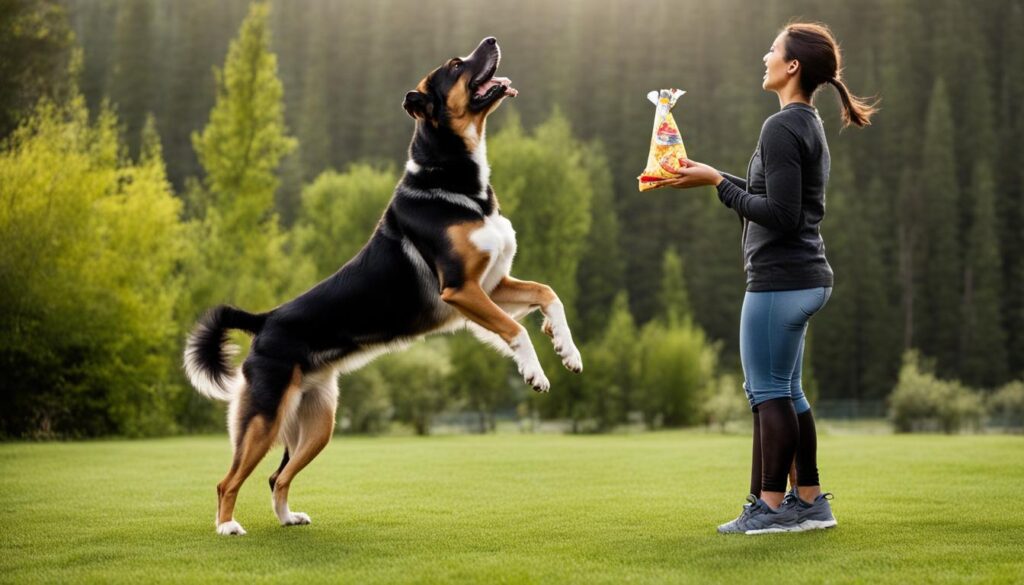
Training is essential for all dogs, but it is particularly important for large breeds due to the potential consequences of their size and strength. Large dogs that exhibit bad behaviors can pose a risk to themselves, others, and property. Therefore, it is crucial to invest time and effort into training them properly to ensure their safety and well-being.
When it comes to training large dogs, focusing on basic manners is essential. Teaching commands such as sit, stay, down, and come will establish a foundation of obedience and control. These fundamental commands should be consistently reinforced to instill good behavior habits.
“Training a large dog requires consistency, patience, and positive reinforcement.”
In addition to basic manners, socialization is crucial for large breeds. It is important to expose them to various environments, people, and other animals from a young age. This will help them become comfortable and well-behaved in different situations. Socialization also plays a significant role in preventing aggression and fear-related behaviors in large dogs.
Mental enrichment activities are equally important for large breeds. These activities can help prevent boredom, which can lead to destructive behaviors. Providing interactive toys, puzzle games, and mental challenges will engage their minds and help them channel their energy constructively.
It is worth mentioning that training modifications may be necessary for large breeds due to their unique needs and capabilities. For example, specific techniques may be required to handle their size and strength during leash training. Additionally, their exercise routines may need adjustments to protect their joints and prevent injuries.
Training Tips for Large Dogs:
- Start training from an early age to establish good habits.
- Focus on positive reinforcement techniques, such as rewards and praise.
- Be consistent and patient throughout the training process.
- Enroll in obedience classes or seek professional help if needed.
- Ensure regular exercise to release excess energy and promote mental well-being.
- Use appropriate training tools, such as sturdy leashes and harnesses.
- Provide mental stimulation through interactive toys and games.
- Practice socialization regularly to promote good behavior with humans and other animals.
By investing time and effort into training large dogs, owners can establish a strong bond and promote good behavior. Remember, training is an ongoing process that requires consistent reinforcement and leadership to ensure the best possible outcomes for both the owner and their beloved canine companion.
Living With a Large Dog
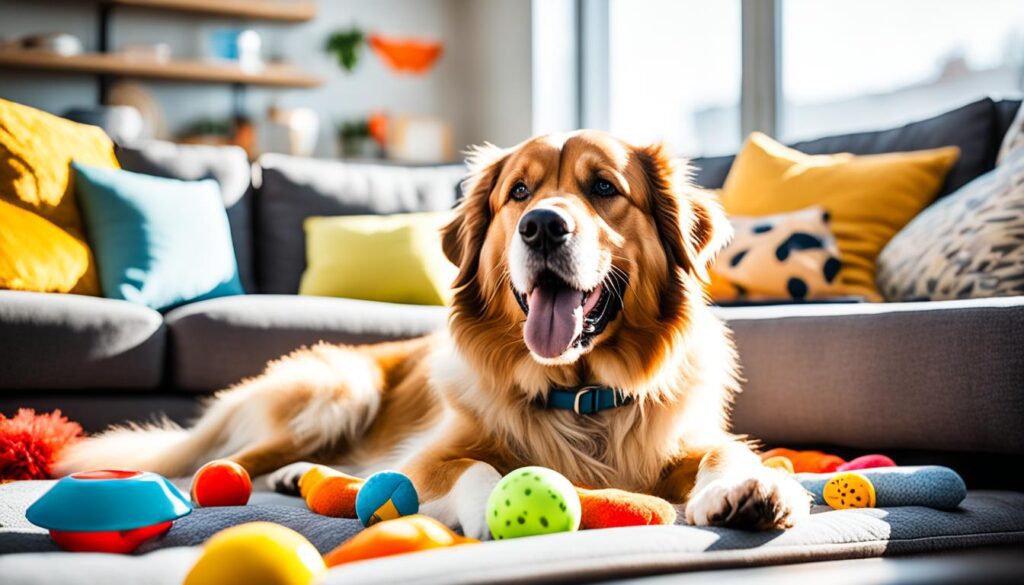
Living with a large dog can be an incredibly rewarding experience, but it also comes with its own set of challenges. From the rapid growth phase to the maturity of these big breeds, understanding their needs and providing the right environment is crucial for their well-being.
During the growth phase, large puppies can be a bit clumsy and may accidentally knock things over. It’s important to create a safe space for them and take precautions to protect fragile items in your home. Providing ample exercise and mental stimulation can help channel their energy in a positive way.
As large dogs mature, they often become calmer and more trustworthy in the home. They tend to have a more laid-back personality compared to their younger selves. This calmness is one of the many reasons why people enjoy living with adult large dogs.
To ensure a harmonious living environment, proper training and socialization are essential. Teaching basic commands and good manners from a young age will go a long way in establishing a well-behaved companion. Socializing your large dog with other dogs and people will help them become confident and well-adjusted.
Proper training, socialization, and a safe environment are key to living harmoniously with a large dog.
The Benefits of Living With a Large Dog
Despite the challenges, there are many wonderful benefits to having a large dog as part of your family. Large breeds can be incredibly loyal and protective, making them great companions. Their size and presence often deter potential intruders, giving you peace of mind.
Large dogs are also known for their gentle nature, making them excellent family pets. They are often patient and tolerant, especially with children. Their calm demeanor can have a soothing effect on everyone in the household.
When properly trained, large dogs can also participate in a variety of activities such as hiking, running, and even therapy work. Their size and strength can be an asset in certain sports and make them a source of pride for their owners.
Creating a Safe Environment
Living with a large dog requires making adjustments to your living space to accommodate their needs. Here are some tips for creating a safe environment:
- Provide plenty of space for your dog to move around comfortably, both indoors and outdoors.
- Ensure your yard is securely fenced to prevent escapes.
- Keep hazardous substances and objects out of reach.
- Invest in sturdy furniture and bedding that can withstand their weight.
- Use baby gates or crate train them to restrict access to certain areas of the house.
Growth and Development
Large breeds typically have a longer growth phase compared to smaller dogs. It’s important to provide them with a balanced diet that supports their growth while preventing excessive weight gain. Consult with your veterinarian to determine the appropriate nutrition for your specific breed, taking into consideration their size and activity level.
| Age | Physical Changes and Challenges |
|---|---|
| Puppyhood | Rapid growth, coordination challenges, teething |
| Adolescence | Increased energy levels, potential for rebellious behavior |
| Adulthood | Stable growth, stronger bones and joints |
Budgeting for a Large Dog
Owning a large dog comes with additional expenses compared to smaller breeds. It’s important to consider these costs when budgeting for your furry friend’s care. Here are some key factors to keep in mind:
Cost of Food
Large dogs require more food than their smaller counterparts. Their size and energy levels necessitate a higher caloric intake. High-quality dog food formulated for large breeds can be more expensive, but it’s worth investing in their nutrition to ensure their overall health and well-being.
Veterinary Care for Large Dogs
Giant breeds may be more prone to certain health issues, which can lead to higher veterinary costs. Regular check-ups, vaccinations, preventive medications, and potential treatments for breed-specific conditions should all be factored into your budget. It’s crucial to provide your large dog with proper veterinary care to detect and address any health concerns early on.
Expenses of Large Dog Care
Aside from food and veterinary care, there are other expenses associated with owning a large dog. These can include grooming, licensing fees, training classes, grooming supplies, toys, and bedding. It’s important to consider these ongoing expenses when planning for your pet’s care.
Budgeting Tips
To help manage the financial responsibilities of owning a large dog, consider the following tips:
- Create a separate budget category for your pet’s expenses
- Research and compare prices for dog food, medications, and supplies
- Consider pet insurance to help cover unexpected medical costs
- Look for discounts and deals on grooming and training services
- Explore options for DIY grooming or basic training at home
By budgeting smartly and making informed choices, you can ensure that your large dog receives the care they need without straining your finances.
Remember, proper nutrition, veterinary care, and preventive measures contribute to the long-term health and longevity of your giant breed. By planning ahead and being financially prepared, you can provide your large dog with a happy and fulfilling life.
Common Changes in Senior Dogs: What to Expect
As dogs age, they undergo various changes that may require special attention and care. It’s important for dog owners to be aware of these changes in order to provide the best possible care for their senior companions. Here are some common changes that can occur in senior dogs:
Greying Fur
One of the most noticeable signs of aging in dogs is the greying of their fur. Just like humans, dogs can develop grey hairs as they get older. This change in fur color is a natural part of the aging process and is generally not a cause for concern. Embrace the beauty of your dog’s greying fur as a testament to their long and happy life.
Reduced Activity and Mobility
Senior dogs often experience a decrease in energy levels and mobility. They may no longer have the same stamina as when they were younger and may prefer shorter walks or more frequent rest periods. It’s important to adjust their exercise routine accordingly and provide them with a comfortable and supportive environment to move around in.
Weight Changes
Weight changes are common in senior dogs. Some may experience weight gain due to reduced activity levels, while others may lose weight due to age-related issues or underlying health conditions. Regular monitoring of your dog’s weight and adjusting their diet accordingly can help maintain a healthy weight and overall well-being.
Hearing and Vision Loss
Just like humans, senior dogs may experience a decline in their hearing and vision abilities. They may become less responsive to sound or have difficulty seeing objects clearly. It’s important to create a safe and secure environment for them by avoiding sudden loud noises and keeping their surroundings free from obstacles.
Behavioral Changes
Behavioral changes can occur in senior dogs as they age. They may become more withdrawn or exhibit signs of anxiety or restlessness. It’s important to provide comfort and reassurance to your senior dog and seek guidance from a veterinarian if these behaviors become concerning or impact their quality of life.
Dental Issues
Senior dogs are more prone to dental problems such as tooth decay, gum disease, and tooth loss. Regular dental care, including brushing their teeth and providing appropriate chew toys, can help prevent these issues. It’s also important to schedule regular dental check-ups with a veterinarian to address any dental concerns.
Medical Issues
Senior dogs are more susceptible to a variety of medical conditions, including arthritis, heart disease, kidney disease, and cancer. Regular veterinary check-ups and screenings can help detect and manage these conditions early on. It’s important to discuss any changes or concerns with your veterinarian to ensure your senior dog receives the necessary medical care and support.
By recognizing and addressing these common changes in senior dogs, you can help ensure their comfort, well-being, and overall quality of life in their golden years.
Conclusion
Caring for giant breeds requires a comprehensive approach that takes into account their unique needs and challenges. This guide has provided valuable insights and tips for proper care, ensuring the health and happiness of your large dog. By following the recommendations in this article and seeking guidance from veterinarians, you can provide the best possible care for your giant breed.
Key takeaways from this guide include:
- Considerations for physical activity: Giant breeds may have specific exercise needs and precautions to protect their joints and overall health.
- Nutrition: It’s important to provide a balanced diet specifically formulated for large-breed dogs to prevent overfeeding and obesity.
- Spay/neuter decisions: Timing can play a crucial role in the long-term health of large-breed dogs, and consultation with a veterinarian is advised.
- Training: Proper training is essential for large dogs, as their size and strength can lead to potential hazards if not properly managed.
- Living arrangements: Creating a safe and comfortable environment for your large dog is important, especially during their rapid growth phase.
- Budgeting: Owning a large dog comes with additional expenses, such as food and veterinary care, so proper budgeting is necessary.
By implementing these general care tips and recommendations, you can ensure that your giant breed thrives and lives a healthy, happy life as an important member of your family.
FAQ
What is considered a giant breed?
Giant breeds are defined as dogs weighing over 90 lbs.
How much exercise do large-breed puppies need?
Large-breed puppies, especially those from working lines, require plenty of exercise. However, precautions must be taken to avoid trauma and potential joint harm due to the slower fusion of growth plates in large breeds. Recommended activities include self-regulated play with other dogs on softer surfaces like grass or sand.
What are the nutritional needs of large-breed puppies?
Large-breed puppies have different nutritional needs compared to smaller breeds. Their growth diets are typically lower in calcium and energy dense to prevent overfeeding and obesity. Feeding a food specifically formulated for large or giant breeds is recommended. Joint supplements can also be given to support joint health.
What should I consider regarding spaying/neutering my large-breed dog?
The appropriate timing for spaying or neutering large-breed dogs is a topic of interest in veterinary research. Early sterilization has been linked to certain health issues, and more research is needed to understand the cause and effect relationship in different breeds. Consultation with a veterinarian is recommended.
How important is training for large dogs?
Training is essential for all dogs but particularly important for large breeds due to their size and strength. Training should focus on basic manners, socialization, and mental enrichment activities to prevent boredom. Modifications may be necessary to address the specific needs and capabilities of large breeds.
What challenges come with living with a large dog?
Living with a large dog presents unique challenges, especially during their rapid growth phase. Large puppies tend to be clumsy, but as they mature, they often become calmer and more trustworthy in the home. Proper training, socialization, and a safe environment are important for their well-being.
What should I budget for when owning a large dog?
Owning a large dog comes with additional expenses compared to smaller breeds. Costs can include food, beds, medicine, and transportation. It is important to budget accordingly and be prepared for the financial responsibilities of providing the best care for your large dog.
What changes can I expect as my dog ages?
As dogs age, they undergo various changes such as greying fur, reduced activity and mobility, weight changes, hearing and vision loss, behavioral changes, dental issues, and increased susceptibility to medical issues. Recognizing and addressing these changes can help ensure the quality of life for senior dogs.
How do I properly care for giant breeds?
Caring for giant breeds requires a comprehensive approach that addresses their specific needs and challenges. This guide has provided valuable insights and tips for proper care, including considerations for physical activity, nutrition, spay/neuter decisions, training, living arrangements, and budgeting. By following these recommendations and seeking guidance from veterinarians, you can ensure the health and happiness of your large dog.

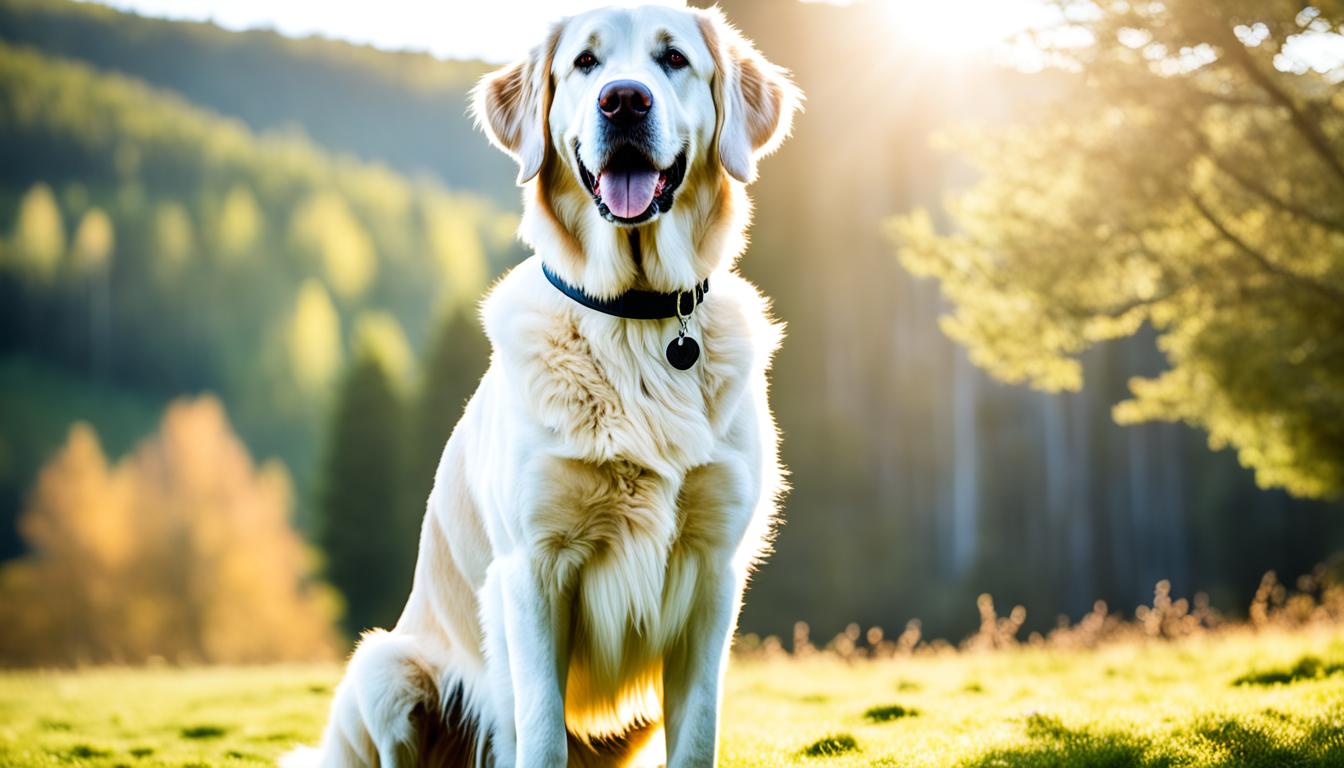




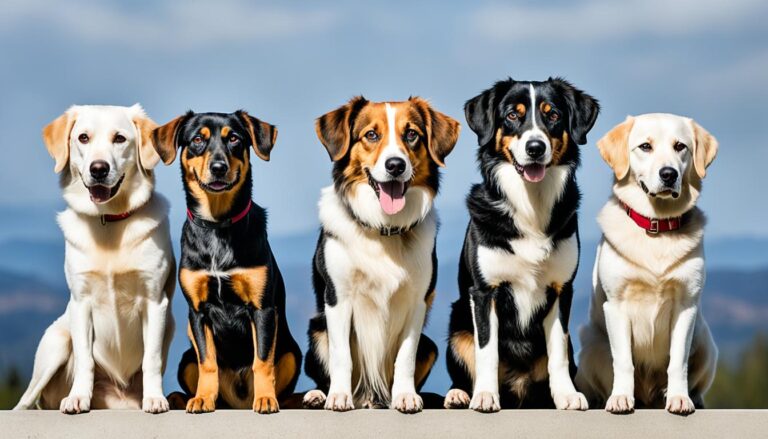

2 Comments